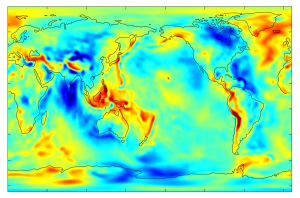22 Gravity
Last chapter we learned that the Earth is pulling on every object. This force is called gravity, and the force of gravity on an object is called the object’s weight. As we now show, gravity is a very peculiar force!
Exercise 22.1: Is Gravity the Same for Every Object?
Okay- so the force of gravity is different on every object. When an objects moves subject to the force of gravity alone we say that the object is in free fall. Let’s examine how an object in free fall moves.
Exercise 22.2: Objects in Free Fall
An object on Earth has weight ![]() and mass
and mass ![]() . It is dropped from a height
. It is dropped from a height ![]() . Find the time it takes for the object to hit the ground.
. Find the time it takes for the object to hit the ground.
We’ll do this following our usual template.
Step 1: Draw a picture. Make sure your drawing includes the force of gravity acting on the object. Label the force of gravity “![]() ” for weight.
” for weight.
Step 2: Find relations. To solve force problems, we always write Newton’s law for each object and for each axis. In this case, we have just one object and one axis that we need to worry about.
C. Imagine you have two objects, one big object (large mass, large weight), and one small object (small mass, small weight). Both objects are dropped from a large height at the same time. Knowing nothing else, can you determine which object will hit the ground first? Justify your answer.
We concluded above that we can’t determine which object hits the ground first. But suppose we try this experiment by dropping, say, a tire, and a big old car at the same time. Which object hits the ground first? Take a guess, and then let’s try the experiment! (Original video can be found here).
This is an astonishing result. Both objects fell to the ground at the same time!
Now- we know this is not always true. For instance, if you drop a bowling ball and a feather from the same height, they do not fall at the same time.
Exercise 22.3: The Feather and the Bowling Ball
Imagine dropping a bowling ball and a feather at the same time. The bowling ball falls faster, but why?
Let’s focus on the feathers for a second. We know that as the feathers fall, they don’t fall straight down. They kind of flutter down in a zig-zaggy way. What does this tell you about the forces acting on the feathers? Based on their motion, how many forces are acting on the feathers, and who is doing the pushing in each case? Justify your answer.
We have a hypothesis: air is pushing the feathers about, and messing with our experiments. If gravity were the only force, would the bowling ball still hit first? Let’s find out.
Credit: BBC.
The conclusion is inescapable: if gravity is the only force, all objects fall to Earth at the exact same rate. The acceleration due to gravity is denoted by the letter ![]() , and has a value of
, and has a value of ![]() .
.
The fact that the acceleration due gravity is the same for every object is an experimental result, and a really surprising one at that! Indeed, it has some rather remarkable implications.
Exercise 22.4: The Law of Gravity
Consider an object of mass ![]() and weight
and weight ![]() . Use Newton’s law to find a relation between
. Use Newton’s law to find a relation between ![]() and
and ![]() in terms of the constant
in terms of the constant ![]() .
.
Bottom line: on Earth, there is a “universal constant” called ![]() . This constant is the acceleration due to Earth’s gravity, and has a value of
. This constant is the acceleration due to Earth’s gravity, and has a value of ![]() . Since this value is constant, it follows that
. Since this value is constant, it follows that
The strength of Earth’s gravitational pull on an object is given by ![]() .
.
This is our first “theory of gravity”: it is a prescription that allows us to calculate the force of gravity on an object. With it, we are able to make predictions for how objects will fall under the action of gravity! Note that our theory is telling us that different objects will experience a different force of gravity, even though they all experience the same acceleration.
It turns out ![]() is not quite a constant: objects on Earth fall at very slightly different accelerations depending on when on Earth you are, as you can see from this map:
is not quite a constant: objects on Earth fall at very slightly different accelerations depending on when on Earth you are, as you can see from this map:

The map shows the acceleration of gravity on Earth: red colors are larger acceleration, and blue colors are smaller acceleration. The differences are tiny: the bright reds and deepest blues differ by only one part in 10,000! Interestingly, you can see gravity pulls slightly stronger on Mountains, and less strong in the middle of the ocean. Why?
To answer this, we will need to wait until we discuss Newton’s theory of gravity.
We have covered a lot of ground, so to end, I’d like you to watch the following video from Veritasium. Keeping everything in our head will require some practice!
Key Takeaways
